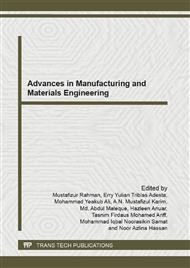p.3
p.7
p.11
p.15
p.19
p.23
p.28
p.32
Application of Permanent Magnets for Chatter Control in End Milling of Titanium Alloy Ti-6Al-4V
Abstract:
Machining of metals is generally accompanied by a violent relative vibration between work and tool, known as chatter. Chatter is undesirable due to its adverse effects on product quality, operation cost, machining accuracy, tool life, and productivity. This paper presents an innovative approach to chatter control during end milling of titanium alloy Ti-6Al-4V using ferrite permanent magnets to reduce the unwanted vibrations. A special fixture was fabricated and mounted on a Vertical Machining Center‘s spindle for holding the permanent magnet bars, used in suppressing the vibration amplitudes. DASY Lab 5.6 was used for signal analysis and processing to compare the intensity of chatter under normal and magnet application conditions. Fast Fourier Transform (FFT) was subsequently used to transform the vibration data to a function of frequency domain. The experiments focused on monitoring the vibration amplitudes and analysis of chip formation process during metal cutting. It was observed that the magnetic fields contributed to reduction of chatter amplitudes. It was apparent that a reduction of chatter amplitude would result in improved surface finish of the work-piece and lead to uniform chip formation.
Info:
Periodical:
Pages:
15-18
Citation:
Online since:
October 2012
Authors:
Keywords:
Price:
Сopyright:
© 2012 Trans Tech Publications Ltd. All Rights Reserved
Share:
Citation:


